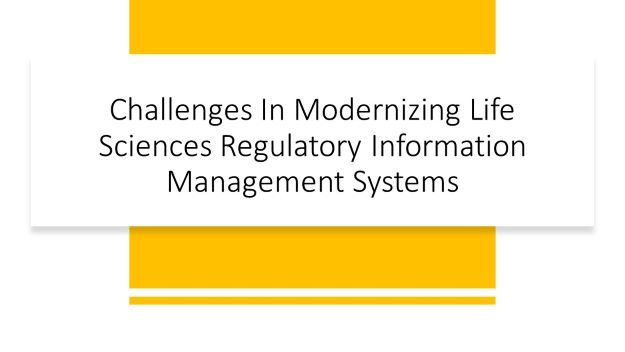Legacy technologies
Life sciences regulatory information management is a challenging process. Traditional processes often require manual data entry and tracking and can be costly. To keep up with the pace of change, life sciences companies need to embrace the latest data and automation technologies. This will help speed electronic submissions, improve data quality and transparency, and save time.
With the latest cloud-based regulatory information management solution, organizations can consolidate and automate their entire regulatory information management process. The cloud-based system unified system allows all stakeholders to access the same documents and data, eliminating manual data entry. With Identification of Medicinal Products IDMP-compliant functionality, it also helps life sciences organizations achieve full IDMP compliance.
Today's life sciences companies face an increasing number of regulatory requirements and ever-growing data volumes. By implementing a modern solution that improves compliance data management, these companies can accelerate product launches and generate millions of dollars in revenue. Regulatory teams can analyze data and make decisions faster with better, more efficient processes. This also allows them to build stronger relationships with regulators and build brand recognition.
Lack of interoperability
While it is true that modernizing life sciences regulatory information management requires the use of a unified data infrastructure, there are many challenges to interoperability. These challenges include differences in data attributes, different rules and regulations, and varying distribution practices. Consequently, it is critical to develop standardized interoperability guidelines.
The life sciences industry continues to face unprecedented challenges. With heightened regulatory scrutiny, globalization, accelerated adoption of cloud technologies, and ever-evolving customer needs, life sciences companies are tasked with navigating a rapidly changing and increasingly complex environment. To address these challenges, life sciences organizations must implement a unified, digital infrastructure with the right technology partners and accelerate the digital transformation of their organization.
Interoperability in life sciences regulatory information management can be achieved by ensuring that data exchange capabilities between systems are consistent. This is done by developing the same language and standards to ensure that data is interchangeable between different systems. These standards also include data structures and formats.
Cost of implementation
Life sciences companies need regulatory information management solutions to stay close to regulators while maintaining agile systems and processes. It is critical to automate cascading changes and calculate the impact of new requirements. These companies also have ambitious goals to become more data-driven and smarter. While they have made great strides in integrating diverse data systems and adopting data-driven regulatory information management, they still face a number of problems, including a lack of process automation.
Today's life sciences regulatory landscape is dynamic and growing more complex every day. As new markets and stakeholder demands grow, the challenges and costs involved in managing this information continue to mount.
Regulatory authorities are focusing on automating processes and streamlining the IT landscape to improve operational efficiency. Lean methodologies are proving to be beneficial in achieving operational efficiency. Lean methodologies such as value stream mapping are helping organizations identify opportunities for improvement. Current regulatory priorities place safety and efficacy ahead of other factors, and these new priorities are requiring innovative ways to streamline the regulatory process.
Cybersecurity threats
Cybersecurity is a growing concern for companies in the life sciences. Companies that do not have adequate cybersecurity measures can be crippled by cyberattacks. As a result, organizations are implementing cybersecurity measures and policies to protect themselves. These measures include minimizing the effects of natural disasters and cyberattacks and implementing backup and recovery strategies. They also include addressing legal and forensic issues and designing and testing continuity plans.
Cybersecurity threats in the life sciences are often caused by organizations compromising systems for malicious reasons. In addition to the financial impact of a data breach, companies face reputational harm and damage from the dissemination of personally identifiable information. They may also face legal fees and regulatory fines.
Related Reading:
- Operational Excellence FAQ: Why should you modernize regulatory information management in life sciences organizations?
- USFDA Guidance on Life Sciences Regulatory Information Management
- Economic Impact of Life Sciences Regulatory Information Management
- What are the drawbacks if Regulatory Information Management (RIM) of life sciences organizations is not modernized?
- Modernize regulatory information management to improve operational excellence in life science organizations
- How to Overcome Challenges in Life Sciences Regulatory Information Management
- Benefits of modernizing life sciences Regulatory Information Management
- Transitioning from Computer Software Validation (CSV) to Computer Software Assurance (CSA)
Follow Shruti on Twitter, Facebook, YouTube, LinkedIn
Categories: Life Sciences | Operational Excellence | Continuous Improvement
Keywords and Tags:
#CSAguidelines #computersoftwareassurance #CSVguidelines #CSVtoCSA #lifesciences #continuousimprovement #operationalexcellence #continuousimprovementforlifescienceindustry #modernizingRIM





















